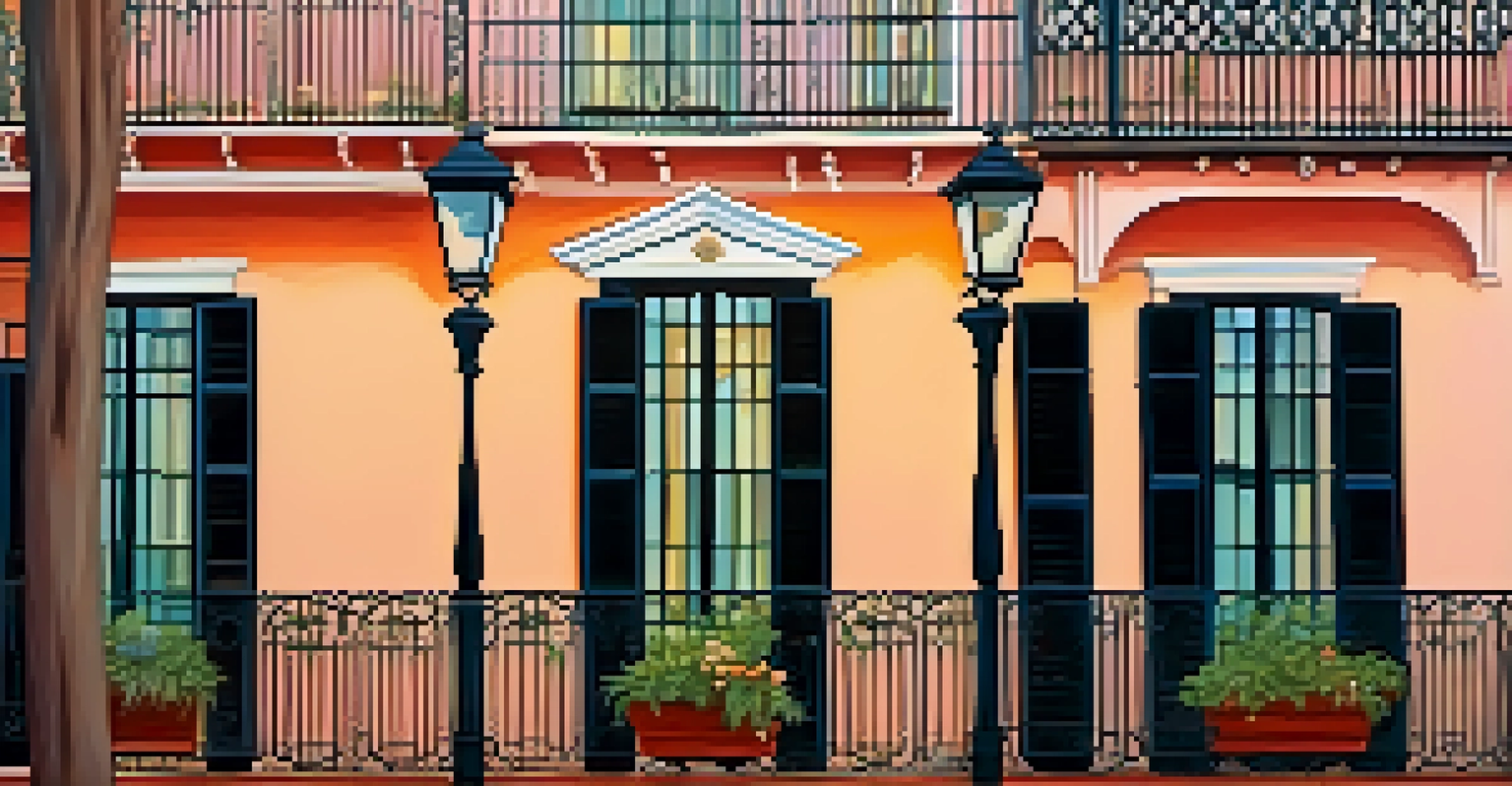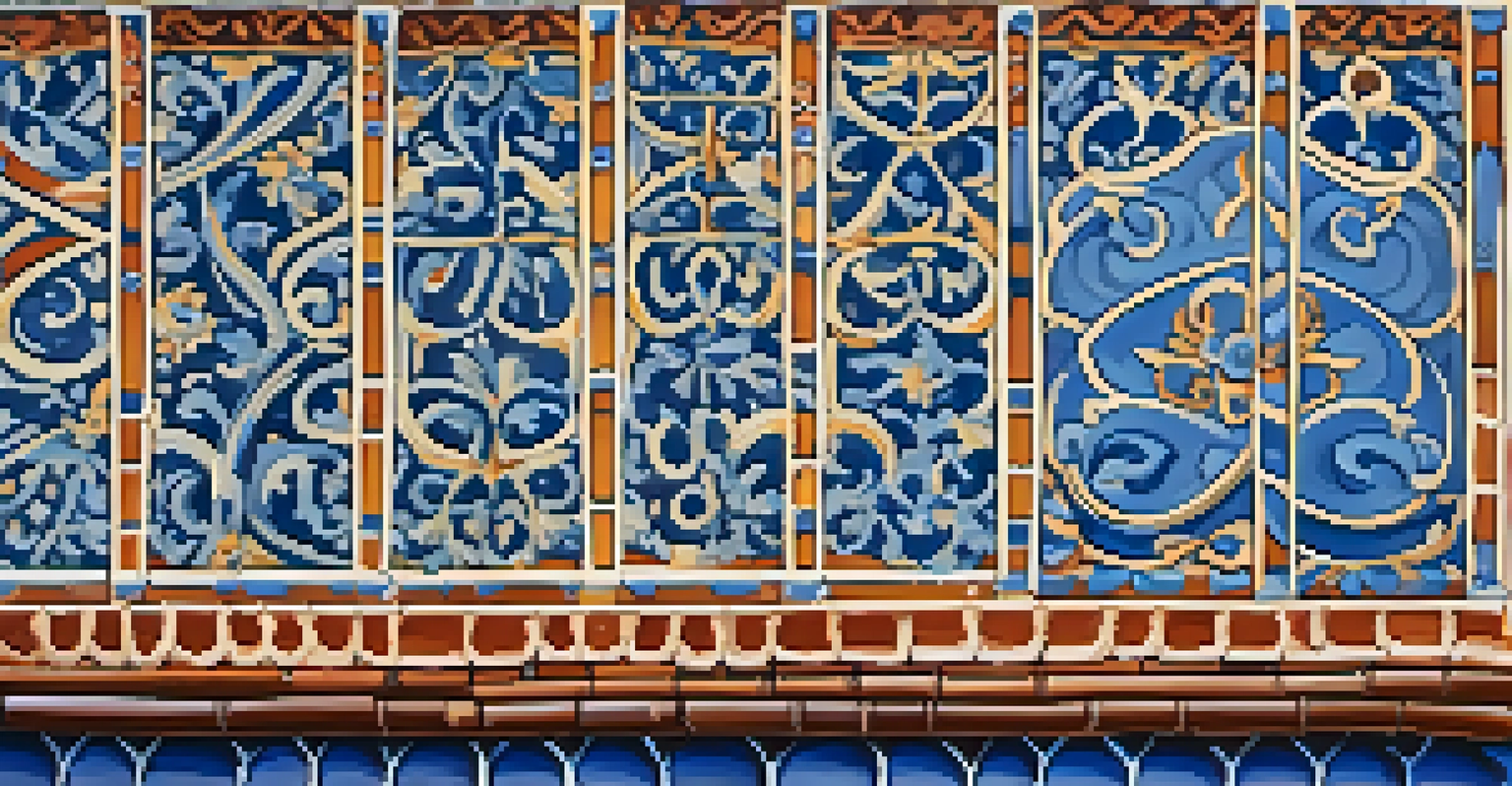Spanish Influences in New Orleans Architecture Explained

A Brief History of Spanish Rule in New Orleans
New Orleans, founded in 1718, was under Spanish control from 1763 to 1803. This period significantly influenced the city's cultural and architectural landscape. The Spanish brought their unique designs and construction methods, which would blend with the existing French styles.
Architecture is the learned game, correct and magnificent, of forms assembled in the light.
During this time, the city experienced a wave of urban development that introduced new building techniques. Spanish colonial architecture often featured elaborate ironwork, tiled roofs, and stucco facades, elements that are still celebrated today. This fusion of styles created a distinctive aesthetic that sets New Orleans apart.
Understanding the historical context of Spanish rule helps us appreciate the rich tapestry of influences that shaped the city. It's like piecing together a puzzle where each piece represents a different culture contributing to the whole.
Key Architectural Features of Spanish Influence
Spanish architecture in New Orleans is characterized by several key features, such as stucco exteriors and wrought iron balconies. These elements not only add to the city's charm but also reflect the practical needs of the climate, allowing for ventilation and cooling. The use of courtyards is another hallmark of Spanish design, providing private outdoor spaces.

One of the most recognizable examples is the iconic shotgun house, which became popular during this era. These narrow, elongated homes were designed to promote airflow, making them comfortable in the humid climate. The way these homes are laid out tells a story of adaptation and innovation.
Spanish Influence Shaped New Orleans
The period of Spanish rule introduced unique architectural styles that blended with French designs, creating a distinctive cultural landscape.
Visiting the French Quarter, you can spot these features everywhere, from the historic buildings to the vibrant colors of the facades. Each structure speaks to the blend of cultures that defines New Orleans, making it a visual feast for architecture lovers.
The Role of Courtyards in Spanish Architecture
Courtyards are a defining characteristic of Spanish architecture, serving both aesthetic and functional purposes. In New Orleans, these spaces are often lush with greenery and provide a serene escape from the bustling streets. They encourage social interaction and community, much like the plazas found in Spain.
Every great architect is - necessarily - a great poet. He must be a great original thinker while expressing the spirit of the age.
These courtyards typically feature tiled floors, fountains, and sometimes even outdoor seating areas. They act as private oases, allowing residents to enjoy the outdoors while maintaining some level of privacy. This design is a testament to the importance of outdoor living in Spanish culture.
As you wander through the streets of New Orleans, take a moment to peek into these hidden gems. Each courtyard tells a story of the people who once lived there and continues to be a vital part of the city's architectural identity.
Wrought Ironwork: A Signature Element
One of the most striking features of Spanish-influenced architecture in New Orleans is the intricate wrought ironwork. This decorative detail can be seen on balconies, gates, and window grilles, adding elegance and charm to the buildings. The craftsmanship involved reflects both artistry and functionality.
Wrought iron was often used in the construction of balconies that extend out from the buildings, allowing residents to enjoy the street view. These romantic spaces are perfect for sipping coffee or enjoying the vibrant atmosphere of the city. It's a beautiful fusion of form and function that enhances the urban landscape.
Key Features: Wrought Iron and Tile
Elements like wrought ironwork and vibrant Spanish tiles are signature characteristics that enhance the charm and functionality of New Orleans' architecture.
As you stroll through the historic districts, the delicate patterns of wrought iron draw your eye and invite you to appreciate the artistry behind these structures. Each piece tells a story of skilled artisans and their dedication to creating something beautiful.
Spanish Tile: Vibrant Colors and Patterns
Spanish tile is another defining feature of New Orleans architecture, known for its vibrant colors and intricate patterns. Often used on roofs and in courtyards, these tiles add a distinctive flair that is both functional and aesthetic. The bright hues reflect the lively spirit of the city and its cultural heritage.
These tiles are not just decorative; they also serve practical purposes, helping to keep homes cooler in the summer heat. The artistry involved in creating these tiles showcases the craftsmanship that has been passed down through generations. It's like wearing a piece of history on your roof.
When you see a building adorned with Spanish tiles, take a moment to admire the craftsmanship and creativity. It’s a reminder of how different cultures can come together to create something truly unique and beautiful.
The Influence of Spanish Colonial Revival Style
The Spanish Colonial Revival style emerged in the early 20th century, drawing inspiration from the earlier Spanish influences in New Orleans. This architectural movement sought to celebrate and revive the romantic elements of Spanish design, resulting in buildings that are both nostalgic and contemporary. It's a beautiful homage to the city's heritage.
Characteristics of this style include colorful stucco exteriors, arched doorways, and decorative tile work. The revival movement brought a renewed appreciation for the historical architecture that had shaped New Orleans. It also inspired new constructions that embraced these classic elements while incorporating modern functionality.
Modern Takes on Spanish Architecture
Contemporary designs in New Orleans continue to draw inspiration from Spanish architecture, blending traditional elements with modern sustainability.
As you explore the city, you'll find numerous examples of this revival style, blending seamlessly with the older structures. Each building stands as a testament to the enduring legacy of Spanish influence in shaping the architectural identity of New Orleans.
Modern Interpretations of Spanish Architecture
Today, Spanish architectural influences can still be seen in modern constructions throughout New Orleans. Architects continue to draw inspiration from the past, incorporating elements like wrought iron and tile into contemporary designs. This blending of old and new creates a unique architectural dialogue that keeps the city's history alive.
Modern interpretations often infuse sustainability and innovation into the traditional styles, ensuring that the legacy of Spanish architecture remains relevant. For example, eco-friendly materials may be used alongside traditional designs, creating energy-efficient homes that honor the past while looking to the future.

When walking through New Orleans, it's fascinating to see how these modern buildings pay homage to their historical roots. The city's architectural evolution is a story of adaptation, showcasing the beauty of cultural influences that continue to thrive.